Introduction
The knee is one of the largest and most
complex joints in the body. Due to its load-bearing capabilities and range of
motion, it is susceptible to injury and pain over time.
اضافة اعلان
The cushioning effect of cartilage between
the bones of the joint may become thinned or worn out. This process is called
wear-and-tear arthritis or more formally known as Osteoarthritis (OA).
As a result, those diagnosed with OA can at
times feel excruciating pain. A study conducted on Jordanians with OA reported
that 44.8 percent of patients felt severe pain due to their condition and that
34.6 percent were in constant pain.
This affliction disproportionally impacts
women over men and typically manifests in later years, although the early
stages can begin much sooner. The World Health Organization (WHO) estimates
that 10 percent of the population over the age of 60 has symptomatic knee OA,
and the prevalence only increases with age.
Causes
and risk factors
The exact cause for OA is still not entirely
determined, but there are frequent correlations within OA and medical history
that suggest potential causes. The common denominator is age. Even though OA
can develop in younger individuals due to other factors, the development of OA
typically occurs around the age of 45.
It is theorized that age is a leading factor
in OA because, over time, it becomes increasingly difficult for the body to
regenerate and heal; in the case of OA, this applies to the cartilage.
Additionally, weight is another significant
factor and may cause the development of OA in younger individuals. Statistics
have shown that with every pound of weight added to the body, 3–4 pounds of
pressure are added to the knee, further accelerating cartilage deterioration.
Stress injuries are another leading factor in
developing OA, and they can take many forms. In lines of work demanding
constant and repetitive heavy lifting (55 pounds and more), kneeling, or
squatting, the likelihood of developing OA increases. Sports requiring agility
and high-impact sports such as soccer or tennis are another cause of stress
injuries and are a potential cause for developing OA sooner in life.
Stretches
and exercises
Although stress and impact can cause OA to
develop sooner in individuals, the cases are much less prominent than those
found in older patients.
Regular and moderate exercise strengthens the
joints and can reduce the risk of developing OA. Furthermore, regular exercise
can help maintain or lower body weight, significantly reducing pressure on the
knees.
On the other hand, stretching can work to
help reduce pain for those with OA and help potentially reduce the risk of
developing OA. Stretching can help individuals relax the muscles that may be
putting stress on the joint and generally increase flexibility and range of
motion.
For those currently afflicted with OA and who
are considering stretching as a way to reduce pain, we will be sharing a few
stretches that can guide you.
Please make sure to consult your doctor or
physiotherapist before attempting these stretches. If sharp or sudden pain is
felt at any point during these stretches, stop the exercises immediately.
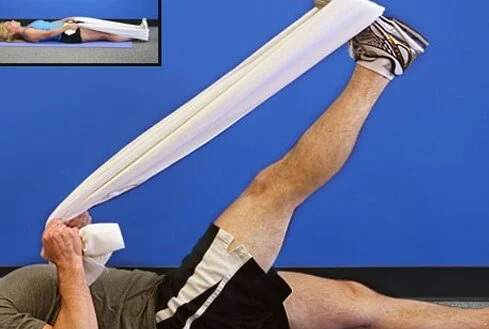 (Photo: WebMD)
(Photo: WebMD)
1- The first stretch is a hamstring stretch.
A hamstring is a group of muscles the runs
along the back of your thigh. It is responsible for bending the knee, and
tension in this muscle group can pull on the joint.
This stretch can be performed in many, but
individuals suffering from pain, old age, or limited mobility may find it
difficult.
To do this stretch, you should lie on your
back comfortably and use something like a bedsheet to wrap around your foot.
Use the sheet to help pull your leg up straight, and this method should help
stretch the hamstring muscle effectively.
Hold the stretch for 20 seconds and perform
twice on each leg.
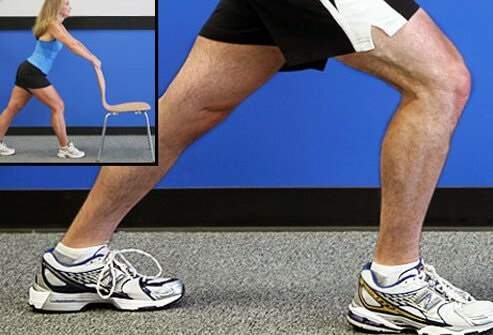 (Photo: WebMD)
(Photo: WebMD)
2- The second stretch is a calf stretch.
The calf is another group of muscles located
behind your shin and anchored at the base of the knee.
To perform this stretch, find a chair for
balance and place one leg in front of you and one behind you. The leg in the
back is the one that will be stretched.
Start by bending the knee of the leg in front
and slowly push the heel of the back leg to the floor. If you don’t feel the
stretch, you can widen your stance or lean forward and further bend the front
knee, making sure not to go past your toes.
Hold this stretch for 20 seconds and perform
twice on each leg.
There are many exercises you can perform to
build muscle and strengthen and support the joint of the knee.
The first exercise is straight leg raises.
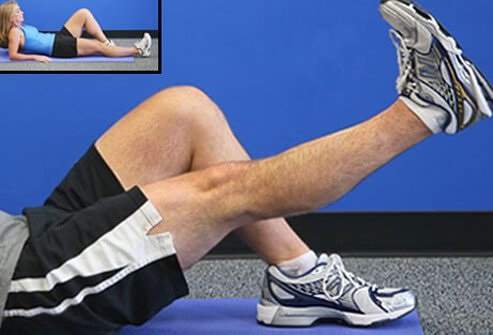 (Photo: WebMD)
(Photo: WebMD)
1- The quadriceps is a group of muscles that run
from the length on the front of the thigh. It is responsible for pulling the
knee straight.
To do this exercise, start by lying on the
floor comfortably and support your upper body with your elbows. Next, bend one
knee at a 90-degree angle with the foot flat on the floor. The other leg should
be tightened, kept straight, and toes pointed upward.
Begin to slowly raise the leg and hold for 3
seconds. Then, while keeping the muscle tightened, slowly lower the leg to the
floor.
Do 10 repetitions twice on each leg.
Alternatively, for those who may find this
exercise difficult, you can perform a quad set.
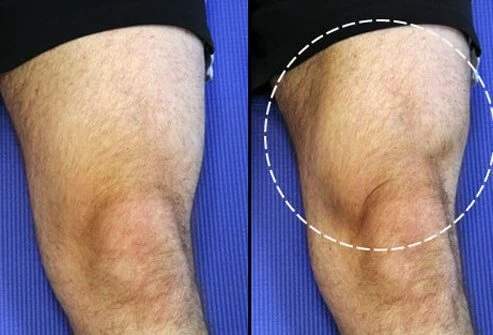 (Photo: WebMD)
(Photo: WebMD)
2- Simply keep both legs straight and tighten
the muscle while resting on the floor. Hold for 5 seconds and then relax.
Perform 10 repetitions twice on each leg.
The second exercise is the seated hip march.
 (Photo: WebMD)
(Photo: WebMD)
3- This exercise helps to strengthen the muscles
in the hips and thighs and is generally helpful to daily activities like
walking or standing.
Begin by sitting in a chair upright. Then
swing your left foot back, keeping your toes on the floor. Next, lift your
right foot off the floor; your knees should be bent at this point. Hold the
pose for 3 seconds and then lower to the ground.
Repeat exercise 10 times and then switch
legs. If that is too difficult, you may use your hands to help lift your legs
up.
The third exercise is the pillow squeeze.
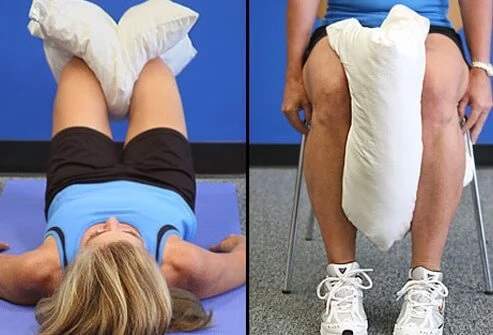 (Photo: WebMD)
(Photo: WebMD)
4- This exercise is designed to strengthen the
inside of your legs to help support your knees.
Start by laying on your back with your knees
bent, and then place a pillow between them. Next, squeeze the pillow with your
knees and hold it for 5 seconds, then release.
Repeat 10 times twice. If you find it to be
too difficult, you may perform the same exercise on a chair.
The fourth exercise is the heel raise.
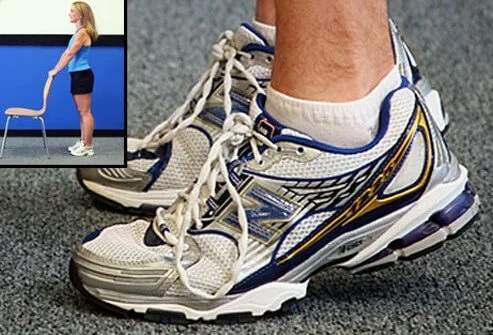 (Photo: WebMD)
(Photo: WebMD)
5- Start by standing upright and hold the back
of a chair for support. Next, lift your heels off the ground slowly and stand
on your toes. Hold this pose for 3 seconds and repeat 10 times.
If you are having any difficulties, you may
also perform this exercise while seated.
This final exercise is step-ups.
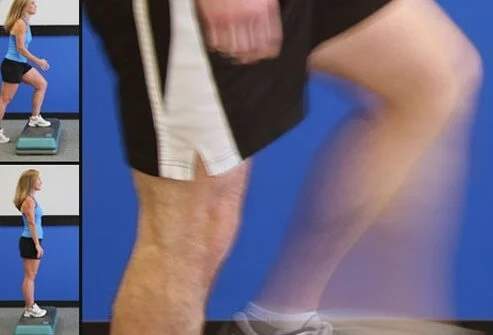
6- Which helps strengthen the lengths for
activities such as climbing stairs.
Start by standing in front of stairs holding
on to the railings for support. Next, place your left foot on a step, tighten
your left thigh muscle and step up with your right foot. Keep muscles tight and
slowly lower right foot back down to the floor.
Do 10 repetitions twice and switch legs.
Read more Health
Sources:
https://www.webmd.com/osteoarthritis/ostearthritis-of-the-knee-degenerative-arthritis-of-the-knee
https://www.medsci.org/v10p0790.html
https://www.webmd.com/osteoarthritis/ss/slideshow-knee-exercises







